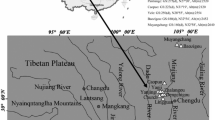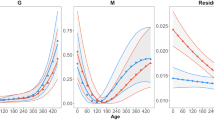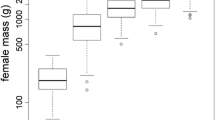Abstract
Fecundity is a primary component of fitness. Theory predicts that the evolution of fecundity through increased brood size results from fecundity selection favouring larger female size to accommodate more offspring and to store more energy. This is expected to generate asymmetric selection on body size between the sexes, ultimately driving evolution of female-biased sexual size dimorphism. Additionally, it has been predicted that the intensity of fecundity selection increases when the opportunities for reproduction are reduced by the limiting thermal effects of increasing latitude-elevation (i.e. decreasing environmental temperatures) on the length of the reproductive season. This later factor would be particularly strong among ectotherms, where reproduction is heavily temperature-dependent. However, this integrative perspective on reproductive evolution by fecundity selection has rarely been investigated. Here, we employ a comparative approach to investigate these predictions in Liolaemus, a prominent lizard radiation. As expected, Liolaemus reproductive output (i.e. offspring number per reproductive episode) increases predictably with increasing female size. However, contrary to predictions, we found that increased fecundity does not translate into female-biased SSD, and that combined latitude-elevation does not impose a detectable effect on fecundity. Finally, our allometric analyses reveal that SSD scales with body size, which supports the occurrence of Rensch’s rule in these lizards. We discuss the evolutionary implications of our results, and the assumptions of the investigated hypotheses.


Similar content being viewed by others
References
Abdala, C. S. (2007). Phylogeny of the boulengeri group (Iguania: Liolaemidae, Liolaemus) based on morphological and molecular characters. Zootaxa, 1538, 1–84.
Abouheif, E., & Fairbairn, D. J. (1997). A comparative analysis of allometry for sexual size dimorphism: Assessing Rensch’s rule. American Naturalist, 149, 540–562.
Andersson, M. (1994). Sexual selection. Princeton: Princeton University Press.
Ashton, K. G. (2002). Do amphibians follow Bergmann’s rule? Canadian Journal of Zoology, 80, 708–716.
Ashton, K. G., & Feldman, C. R. (2003). Bergmann’s rule in nonavian reptiles: turtles follow it, lizards and snakes reverse it. Evolution, 57, 1151–1163.
Blackburn, D. G. (2000). Reptilian viviparity: past research, future directions, and appropriate models. Comparative Biochemistry and Physiology A, 127, 391–409.
Blanckenhorn, W. U., Dixon, A. F. G., Fairbairn, D. J., Foellmer, M. W., Gibert, P., van der Linde, K., et al. (2007a). Proximate causes of Rensch’s rule: does sexual size dimorphism in arthropods result from sex differences in development time? American Naturalist, 169, 245–257.
Blanckenhorn, W. U., Meier, R., & Teder, T. (2007b). Rensch’s rule in insects: patterns among and within species. In D. J. Fairbairn, W. U. Blanckenhorn, & T. Szekely (Eds.), Sex, size & gender roles. Evolutionary studies of sexual size dimorphism (pp. 60–70). Oxford: Oxford University Press.
Braña, F. (1996). Sexual dimorphism in lacertid lizards: male head increase vs. female abdomen increase. Oikos, 75, 511–523.
Brown, R. P., Znari, M., El Mouden, E. L. H., & Harris, P. (1999). Estimating asymptotic body size and testing geographic variation in Agama impalearis. Ecography, 22, 277–283.
Calder, W. A. (1984). Size, function and life history. Massachusetts: Harvard University Press.
Cei, J. M. (1993). Reptiles del noroeste, nordeste y este de la Argentina. Herpetofauna de las selvas subtropicales, puna y pampas. Museo Regionale di Scienze Naturali di Torino, Torino.
Charlesworth, B., & Charlesworth, D. (2010). Elements of evolutionary genetics. Colorado: Roberts and Company.
Cox, R. M., Skelly, S. L., & John-Alder, H. B. (2003). A comparative test of adaptive hypotheses for sexual size dimorphism in lizards. Evolution, 57, 1653–1669.
Cox, R. M., Butler, M., & John-Alder, H. B. (2007). The evolution of sexual size dimorphism in reptiles. In D. J. Fairbairn, W. U. Blanckenhorn, & T. Szekely (Eds.), Sex, size & gender roles. Evolutionary studies of sexual size dimorphism (pp. 38–49). Oxford: Oxford University Press.
Cruz, F. B., Fitzgerald, L. A., Espinoza, R. E., & Schulte, J. A. (2005). The importance of phylogenetic scale in tests of Bergmann’s and Rapoport’s rules: lessons from a clade of South American lizards. Journal of Evolutionary Biology, 18, 1559–1574.
Darwin, C. (1874). The descent of man and selection in relation to sex (2nd ed.). New York: Appleton.
de Queiroz, A., & Ashton, K. G. (2004). The phylogeny of a species-level tendency: species heritability and possible deep origins of Bergmann’s rule in tetrapods. Evolution, 58, 1674–1684.
Espinoza, R. E., & Lobo, F. (1996). Possible communal nesting in two species of Liolaemus lizards (Iguania: Tropiduridae) from northern Argentina. Herpetological Natural History, 4, 65–68.
Espinoza, R. E., Wiens, J. J., & Tracy, C. R. (2004). Recurrent evolution of herbivory in small, cold-climate lizards: breaking the ecophysiological rules of reptilian herbivory. Proceedings of the National Academy of Sciences, USA, 101, 16819–16824.
Fairbairn, D. J. (1997). Allometry for sexual size dimorphism: pattern and process in the coevolution of body size in males and females. Annual Review of Ecology, Evolution, and Systematics, 28, 659–687.
Fairbairn, D. J. (2006). Defining and measuring fitness. In C. W. Fox & J. B. Wolf (Eds.), Evolutionary genetics. Concepts and case studies (pp. 52–54). Oxford: Oxford University Press.
Fairbairn, D. J. (2007). The enigma of sexual size dimorphism. In D. J. Fairbairn, W. U. Blanckenhorn, & T. Szekely (Eds.), Sex, size & gender roles. Evolutionary studies of sexual size dimorphism (pp. 1–10). Oxford: Oxford University Press.
Fairbairn, D. J., & Shine, R. (1993). Patterns of sexual size dimorphism in seabirds of the southern hemisphere. Oikos, 68, 139–145.
Fairbairn, D. J., Blanckenhorn, W. U., & Szekely, T. (2007). Sex, size & gender roles. Evolutionary studies of sexual size dimorphism. Oxford: Oxford University Press.
Felsenstein, J. (1985). Phylogenies and the comparative method. American Naturalist, 125, 1–15.
Fitch, H. S. (1970). Reproductive cycles in lizards and snakes (Vol. 52, pp. 1–247). University of Kansas Museum of Natural History, Miscellaneous Publications.
Fitch, H. S. (1978). Sexual size differences in the genus Sceloporus (Vol. 51, pp. 441–461). University of Kansas Museum of Natural History, Miscellaneous Publications.
Fitch, H. S. (1981). Sexual size differences in reptiles (Vol. 70, pp. 1–72). University of Kansas Museum of Natural History, Miscellaneous Publications.
Fitch, H. S. 1985. Variation in clutch and litter size in New World reptiles. (Vol. 76, pp. 1–76). University of Kansas Museum of Natural History, Miscellaneous Publications.
Freckleton, R. P. (2009). The seven deadly sins of comparative analysis. Journal of Evolutionary Biology, 22, 1367–1375.
Frýdlová, P., & Frynta, D. (2010). A test of Rensch’s rule in varanid lizards. Biological Journal of the Linnean Society, 100, 293–306.
Garcia-Berthou, E. (2001). On the misuse of residuals in ecology: testing regression residuals vs. the analysis of covariance. Journal of Animal Ecology, 70, 708–711.
Garland, T., Harvey, P. H., & Ives, A. R. (1992). Procedures for the analysis of comparative data using phylogenetically independent contrasts. Systematic Biology, 41, 18–32.
Garland, T., Dickerman, A. W., Janis, C. M., & Jones, J. A. (1993). Phylogenetic analysis of covariance by computer simulation. Systematic Biology, 42, 265–292.
Ghiselin, M. T. (1974). The economy of nature and the evolution of sex. Berkeley: University of California Press.
Green, A. J. (2001). Mass/length residuals: measures of body condition or generators of spurious results? Ecology, 82, 1473–1483.
Harvey, P. H., & Pagel, M. D. (1991). The comparative method in evolutionary biology. Oxford: Oxford University Press.
Harvey, P. H., & Rambaut, A. (2000). Comparative analyses for adaptive radiations. Philosophical Transactions of the Royal Society of London, B, 355, 1599–1605.
Head, G. (1995). Selection on fecundity and variation in the degree of sexual size dimorphism among spider species (class Araneae). Evolution, 49, 776–781.
Husak, J. F., Lappin, A. K., & Van Den Bussche, R. A. (2009). The fitness advantage of a high-performance weapon. Biological Journal of the Linnean Society, 96, 840–845.
LaBarbera, M. (1989). Analyzing body size as a factor in ecology and evolution. Annual Review of Ecology and Systematics, 20, 97–117.
Losos, J. B. (2009). Lizards in an evolutionary tree. Ecology and adaptive radiation of anoles. California: University of California Press.
Losos, J. B., Butler, M., & Schoener, T. W. (2003). Sexual dimorphism in body size and shape in relation to habitat use among species of Caribbean Anolis lizards. In S. F. Fox, J. K. McCoy, & T. A. Baird (Eds.), Lizard social behaviour (pp. 356–380). Baltimore and London: John Hopkins University Press.
Lutgens, F. K., & Tarbuck, E. J. (1998). The atmosphere. An introduction to meteorology. New Jersey: Prentice Hall.
Martins, E. P. (2004). COMPARE, version 4.6b. Computer programs for the statistical analysis of comparative data. Distributed by the author at http://compare.bio.indiana.edu/. Department of Biology, Indiana University, Indiana.
Martins, E. P., & Garland, T. (1991). Phylogenetic analyses of the correlated evolution of continuous characters: a simulation study. Evolution, 45, 534–557.
Meiri, S. (2008). Evolution and ecology of lizard body sizes. Global Ecology and Biogeography, 17, 724–734.
Peters, R. H. (1983). The ecological implications of body size. Cambridge: Cambridge University Press.
Pianka, E. R., & Vitt, L. J. (2003). Lizards. Windows to the evolution of diversity. Berkeley, Los Angeles, London: University of California Press.
Pincheira-Donoso, D. (2010). The balance between predictions and evidence and the search for universal macroecological patterns: taking Bergmann’s rule back to its endothermic origin. Theory in Biosciences, 129, 247–253.
Pincheira-Donoso, D., Scolaro, J. A., & Schulte, J. A. (2007a). The limits of polymorphism in Liolaemus rothi: molecular and phenotypic evidence for a new species of the Liolaemus boulengeri clade (Iguanidae, Liolaemini) from boreal Patagonia of Chile. Zootaxa, 1452, 25–42.
Pincheira-Donoso, D., Tregenza, T., & Hodgson, D. J. (2007b). Body size evolution in South American Liolaemus lizards of the boulengeri clade: a contrasting reassessment. Journal of Evolutionary Biology, 20, 2067–2071.
Pincheira-Donoso, D., Hodgson, D. J., & Tregenza, T. (2008a). The evolution of body size under environmental gradients in ectotherms: why should Bergmann’s rule apply to lizards? BMC Evolutionary Biology, 8, 68.
Pincheira-Donoso, D., Scolaro, J. A., & Sura, P. (2008b). A monographic catalogue on the systematics and phylogeny of the South American iguanian lizard family Liolaemidae (Squamata, Iguania). Zootaxa, 1800, 1–85.
Pincheira-Donoso, D., Hodgson, D. J., Stipala, J., & Tregenza, T. (2009). A phylogenetic analysis of sex-specific evolution of ecological morphology in Liolaemus lizards. Ecological Research, 24, 1223–1231.
Pough, F. H. (1973). Lizard energetics and diet. Ecology, 54, 837–844.
Pough, F. H., Andrews, R. M., Cadle, J. E., Crump, M. L., Savitzky, A. H., & Wells, K. D. (2004). Herpetology (3rd ed.). New Jersey: Pearson, Prentice Hall.
Powell, G. L. & Russell, A. P. (2007). Life history implications for conservation and monitoring of lizards in Canada. In: C. N. L. Seburn & C. A. Bishop (eds.), Ecology, conservation, and status of reptiles in Canada (pp. 23–40). Herpetological Conservation 2.
Reznick, D. N. (1985). Costs of reproduction: an evaluation of the empirical evidence. Oikos, 44, 257–267.
Roff, D. A. (2002). Life history evolution. Sunderland: Sinauer Associates.
Schluter, D. (2000). The ecology of adaptive radiation. Oxford: Oxford University Press.
Schulte, J. A., Macey, J. R., Espinoza, R. E., & Larson, A. (2000). Phylogenetic relationships in the iguanid lizard genus Liolaemus: multiple origins of viviparous reproduction and evidence for recurring Andean vicariance and dispersal. Biological Journal of the Linnean Society, 69, 75–102.
Seigel, R. A., & Ford, N. B. (1987). Reproductive ecology. In R. A. Seigel, J. T. Collins, & S. S. Novak (Eds.), Snakes. Ecology and evolutionary biology (pp. 210–252). New York: Macmillan.
Shine, R. (1988). The evolution of large body size in females: a critique of Darwin’s “fecundity advantage” model. American Naturalist, 131, 124–131.
Shine, R. (1994). Sexual size dimorphism in snakes revisited. Copeia, 1994, 326–346.
Shine, R. (2005). Life-history evolution in reptiles. Annual Reviews of Ecology, Evolution and Systematics, 36, 23–46.
Sinervo, B. (2000). Adaptation, natural selection, and optimal life-history allocation in the face of genetically based trade-offs. In T. A. Mousseau, B. Sinervo, & J. A. Endler (Eds.), Adaptive genetic variation in the wild (pp. 41–64). Oxford: Oxford University Press.
Smith, R. J. (1999). Statistics of sexual size dimorphism. Journal of Human Evolution, 36, 423–459.
Sokal, R. R., & Rohlf, F. J. (1995). Biometry: the principles and practice of statistics in biological research. California: W. H. Freeman.
Stearns, S. C. (1992). The evolution of life histories. Oxford: Oxford University Press.
Stephens, P. R., & Wiens, J. J. (2009). Evolution of sexual size dimorphisms in emydid turtles: ecological dimorphism, Rensch’s rule, and sympatric divergence. Evolution, 63, 910–925.
Stuart-Fox, D. (2009). A test of Rensch’s rule in dwarf chameleons (Bradypodion spp.), a group with female-biased sexual size dimorphism. Evolutionary Ecology, 23, 425–433.
Tabachnick, B. G., & Fidell, L. S. (2007). Using multivariate statistics. Massachusetts: Pearson International.
Thornhill, T., & Alcock, J. (1983). The evolution of insect mating systems. Massachusetts: Harvard University Press.
Tinkle, D. W., Wilbur, H. M., & Tilley, S. G. (1970). Evolutionary strategies in lizard reproduction. Evolution, 24, 55–74.
Trivers, R. (1972). Parental investment and sexual selection. In B. Campbell (Ed.), Sexual selection and the descent of man, 1871–1971 (pp. 136–179). Chicago: Aldine.
Vanhooydonck, B., Cruz, F. B., Abdala, C. S., Moreno-Azocar, D. L., Bonino, M. F., & Herrel, A. (2010). Sex-specific evolution of bite performance in Liolaemus lizards (Iguania: Liolaemidae): the battle of the sexes. Biological Journal of the Linnean Society, 101, 461–475.
Vitt, L. J. (1986). Reproductive tactics of sympatric gekkonid lizards with a comment on the evolutionary and ecological consequences of invariant clutch size. Copeia, 1986, 773–786.
Weiblen, G. D., Oyama, R. K., & Donoghue, M. J. (2000). Phylogenetic analysis of dioecy in monocotyledons. American Naturalist, 155, 46–58.
Williams, G. C. (1966). Adaptation and natural selection. New Jersey: Princeton University Press.
Zamudio, K. R. (1998). The evolution of female-biased sexual size dimorphism: a population-level comparative study in horned lizards (Phrynosoma). Evolution, 52, 1821–1833.
Zar, J. H. (2009). Biostatistical analysis. New Jersey: Pearson International.
Acknowledgments
We are grateful to Wolf Blanckenhorn for advice on a set of quantitative analyses and for providing his excel file prepared for major-axis regressions. Dave Hodgson also provided valuable quantitative advice. This manuscript benefited from discussions and insightful observations made by Jan Stipala. Two anonymous referees provided sharp and insightful observations that made an important contribution to improve this paper. This study was funded by the Leverhulme Trust.
Author information
Authors and Affiliations
Corresponding author
Electronic supplementary material
Below is the link to the electronic supplementary material.
Rights and permissions
About this article
Cite this article
Pincheira-Donoso, D., Tregenza, T. Fecundity Selection and the Evolution of Reproductive Output and Sex-Specific Body Size in the Liolaemus Lizard Adaptive Radiation. Evol Biol 38, 197–207 (2011). https://doi.org/10.1007/s11692-011-9118-7
Received:
Accepted:
Published:
Issue Date:
DOI: https://doi.org/10.1007/s11692-011-9118-7




